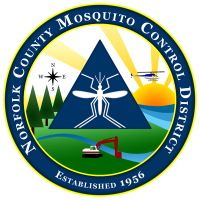What Are Synethhic Pyrethroids?
Pyrethroids are synthetic chemical insecticides that act in a similar manner to pyrethrins, which are derived from chrysanthemum flowers. Pyrethroids are widely used for controlling various insects. Permethrin, resmethrin, and sumithrin are synthetic pyrethroids commonly used in mosquito control programs to kill adult mosquitoes.
Permethrin has been registered by EPA since 1977. It is currently registered and sold in a number of products such as household insect foggers and sprays, tick and flea sprays for yards, flea dips and sprays for cats and dogs, termite treatments, agricultural and livestock products, and mosquito abatement products.
Resmethrin has been registered by EPA since 1971 and is used to control flying and crawling insects in the home, lawn, garden, and industrial sites. It can also be used to control insects on ornamental plants (outdoor and greenhouse use), on pets and horses, and as a mosquitocide. Because of its toxicity to fish, resmethrin is a Restricted Use Pesticide (RUP) that is available for use only by certified pesticide applicators or persons under their direct supervision.
Sumithrin has been registered by EPA since 1975 and is used to control adult mosquitoes and as an insecticide in transport vehicles such as aircraft, ships, railroad cars, and truck trailers. It is also used as an insecticide and miticide in commercial, industrial, and institutional nonfood areas, in homes and gardens, in greenhouses, and in pet quarters and on pets.
How Are They Used?
Most pyrethroid mosquito control products can be applied only by public health officials and trained personnel of mosquito control districts. Mosquito control professionals apply pyrethroids as an ultra low volume (ULV) spray. ULV sprayers dispense very fine aerosol droplets that stay aloft and kill adult mosquitoes on contact. Pyrethroids used in mosquito control are typically mixed with a synergist compound, such as piperonyl butoxide, which enhances the effectiveness of the active ingredient. The product is often diluted in water or oil and applied at rates less than 1/100th of a pound of active ingredient or less than 4 fluid ounces of mixed formulation per acre.
Do They Pose Risks to Human Health?
Pyrethroids can be used for public health mosquito control programs without posing unreasonable risks to human health when applied according to the label. Pyrethroids are considered to pose slight risks of acute toxicity to humans, but at high doses, pyrethroids can affect the nervous system.
Do They Pose Risks to Wildlife or the Environment?
Pyrethroids used in mosquito control programs do not pose unreasonable risks to wildlife or the environment. Pyrethroids, when applied at mosquito control rates, are low in toxicity to mammals, and are practically nontoxic to birds. Mosquito control formulations of permethrin break down in the environment, and high temperatures and sunlight accelerate this process. However, pyrethroids are toxic to fish and to bees. For that reason, EPA has established specific precautions on the label to reduce such risks, including restrictions that prohibit the direct application of products to open water or within 100 feet of lakes, streams, rivers or bays.
What is the Current Regulatory Status of Pyrethroids?
As part of its responsibility to reassess all pesticides registered before 1984, EPA has given highest priority to reviewing more acutely toxic pesticides such as organophosphates and carbamates. Organophosphates are currently under review. Comprehensive reviews of the synthetic pyrethroids are scheduled for approximately 2004.

